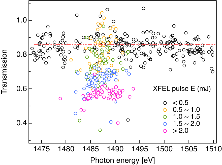Observation of Reverse Saturable Absorption of an X-ray Laser
- Inst. of Basic Science, Gwangju (Korea, Republic of); Gwangju Inst. of Science and Technology (Korea, Republic of)
- Intl Atomic Energy Agency (IAEA), Vienna (Austria)
- Lawrence Berkeley National Lab. (LBNL), Berkeley, CA (United States)
- Academy of Sciences of the Czech Republic (ASCR), Prague (Czech Republic). Inst. of Physics
- Univ. of Oxford (United Kingdom)
- SLAC National Accelerator Lab., Menlo Park, CA (United States)
- Univ. of California, Berkeley, CA (United States)
- Deutsches Elektronen-Synchrotron (DESY), Hamburg (Germany)
- European X-ray Free-Electron Laser (XFEL), Schenefeld (Germany)
A nonlinear absorber in which the excited state absorption is larger than the ground state can undergo a process called reverse saturable absorption. It is a well-known phenomenon in laser physics in the optical regime, but is more difficult to generate in the x-ray regime, where fast nonradiative core electron transitions typically dominate the population kinetics during light matter interactions. Here, we report the first observation of decreasing x-ray transmission in a solid target pumped by intense x-ray free electron laser pulses. The measurement has been made below the K-absorption edge of aluminum, and the x-ray intensity ranges are 1016 –1017 W=cm2. It has been confirmed by collisional radiative population kinetic calculations, underscoring the fast spectral modulation of the x-ray pulses and charge states relevant to the absorption and transmission of x-ray photons. The processes shown through detailed simulations are consistent with reverse saturable absorption, which would be the first observation of this phenomena in the x-ray regime. These light matter interactions provide a unique opportunity to investigate optical transport properties in the extreme state of matters, as well as affording the potential to regulate ultrafast x-ray freeelectron laser pulses.
- Research Organization:
- SLAC National Accelerator Lab., Menlo Park, CA (United States)
- Sponsoring Organization:
- USDOE Office of Science (SC), Basic Energy Sciences (BES)
- Grant/Contract Number:
- IBS-R012-D1; NRF-2016R1A2B4009631; NRF-2015R1A5A1009962; EP/H035877/1; EP/L000849/1; AC02-76SF00515
- OSTI ID:
- 1390622
- Alternate ID(s):
- OSTI ID: 1375496
- Journal Information:
- Physical Review Letters, Vol. 119, Issue 7; ISSN 0031-9007
- Publisher:
- American Physical Society (APS)Copyright Statement
- Country of Publication:
- United States
- Language:
- English
Web of Science
Observations of non-linear plasmon damping in dense plasmas
|
journal | May 2018 |
Similar Records
Diagnosis of warm dense conditions in foil targets heated by intense femtosecond laser pulses using Kα imaging spectroscopy
X-RAY NONLINEAR OPTICAL PROCESSES IN ATOMS USING A SELF-AMPLIFIED SPONTANEOUS EMISSION FREE-ELECTRON LASER


